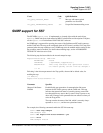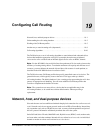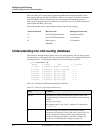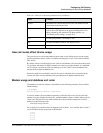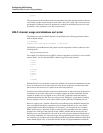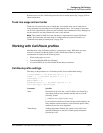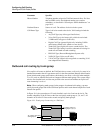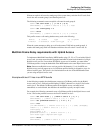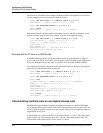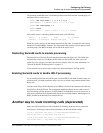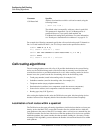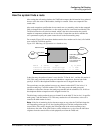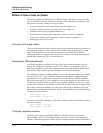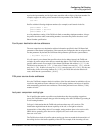
Configuring Call Routing
Working with Call-Route profiles
APX 8000/MAX TNT/DSLTNT Physical Interface Configuration Guide Preliminary May 9, 2000 19-7
Without an explicit call route for trunk group 8, the system always tries the first E1 card, finds
that it does not use trunk group 8, and then drops the call.
The following commands create an explicit call route for trunk group 8:
admin> new call-route { { { 1 16 0 } 0} 0}
CALL-ROUTE/{ { { shelf-1 slot-16 0 } 0 } 0 } read
admin> set trunk-group = 8
admin> write
CALL-ROUTE/{ { { shelf-1 slot-16 0 } 0 } 0 } written
This profile creates a call-routing database entry such as the following:
device # source type tg sa phone
1:16:01/1 0 0:00:00/0 trunk-call-type 8 0
When the system attempts to bring up a call to the remote TAOS unit on trunk group 8, it
matches the trunk-group field in its database and directs the call to the E1 card in slot 16.
Multilink Frame Relay requirements with Hybrid Access
To implement a Multilink Frame Relay (MFR) bundle using a T1, E1, or T3 card with a Hybrid
Access card, you must ensure that the aggregate bandwidth is bound to the channels of a single
Hybrid Access card. So, if more than one Hybrid Access card is installed, you must define
Call-Route profiles to map the bandwidth of the MFR bundle to the same Hybrid Access card.
Note: Because one Hybrid Access card can provide 186 channels (31 x 6) for MFR, one
Hybrid Access card can support up to six Call-Route profiles binding its channels to up to six
back-to-back E1 ports. This places a six-line limitation on the size of the MFR bundle when
you are using an Hybrid Access card.
Example with two E1 lines in an MFR bundle
In the following example, the administrator creates two Call-Route profiles for the Hybrid
Access card in slot 3, with each profile binding 31 HDLC channels to a single E1 line on the
card in slot 2. The default Call-Route profile for the Hybrid Access card must be left
unmodified, or can be deleted, but should not be modified to specify an explicit route.
For example, the following commands create a Call-Route profile for the Hybrid Access card
in slot 3 and set the preferred source to the first E1 interface in slot 2:
admin> new call-route { { { shelf-1 slot-3 0 } 0 } 1 }
CALL-ROUTE/{ { { shelf-1 slot-3 0 } 0 } 1 } read
admin> set preferred-source = { { 1 2 1 } 0 }
admin> list
[in CALL-ROUTE/{ { { shelf-1 slot-3 0 } 0 } 1 } (new) (changed)]
index* = { { { shelf-1 slot-3 0 } 0 } 1 }
trunk-group = 0
phone-number = ""
preferred-source = { { shelf-1 slot-2 1 } 0 }
call-route-type = digital-call-type
admin> write
CALL-ROUTE/{ { { shelf-1 slot-3 0 } 0 } 1 } written



